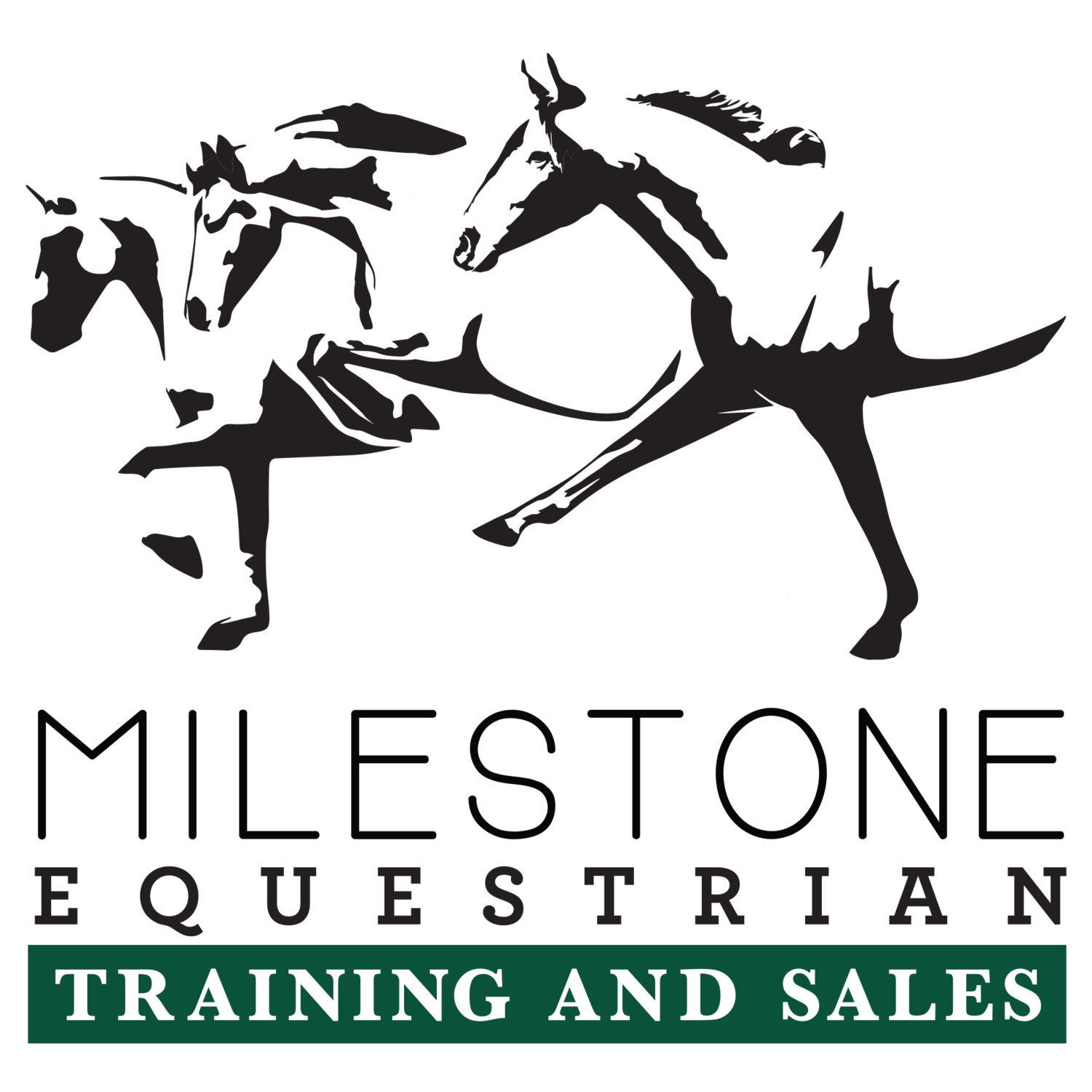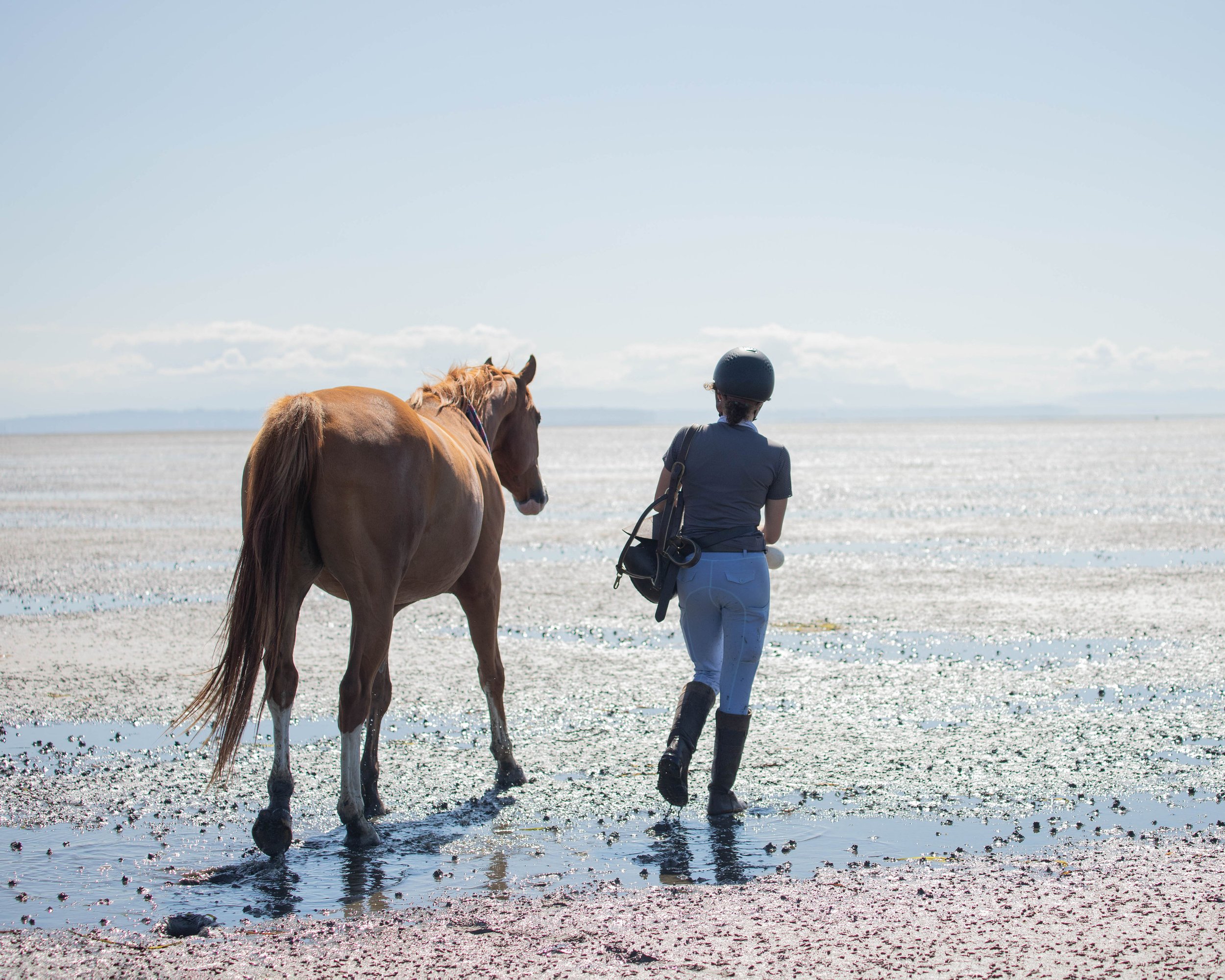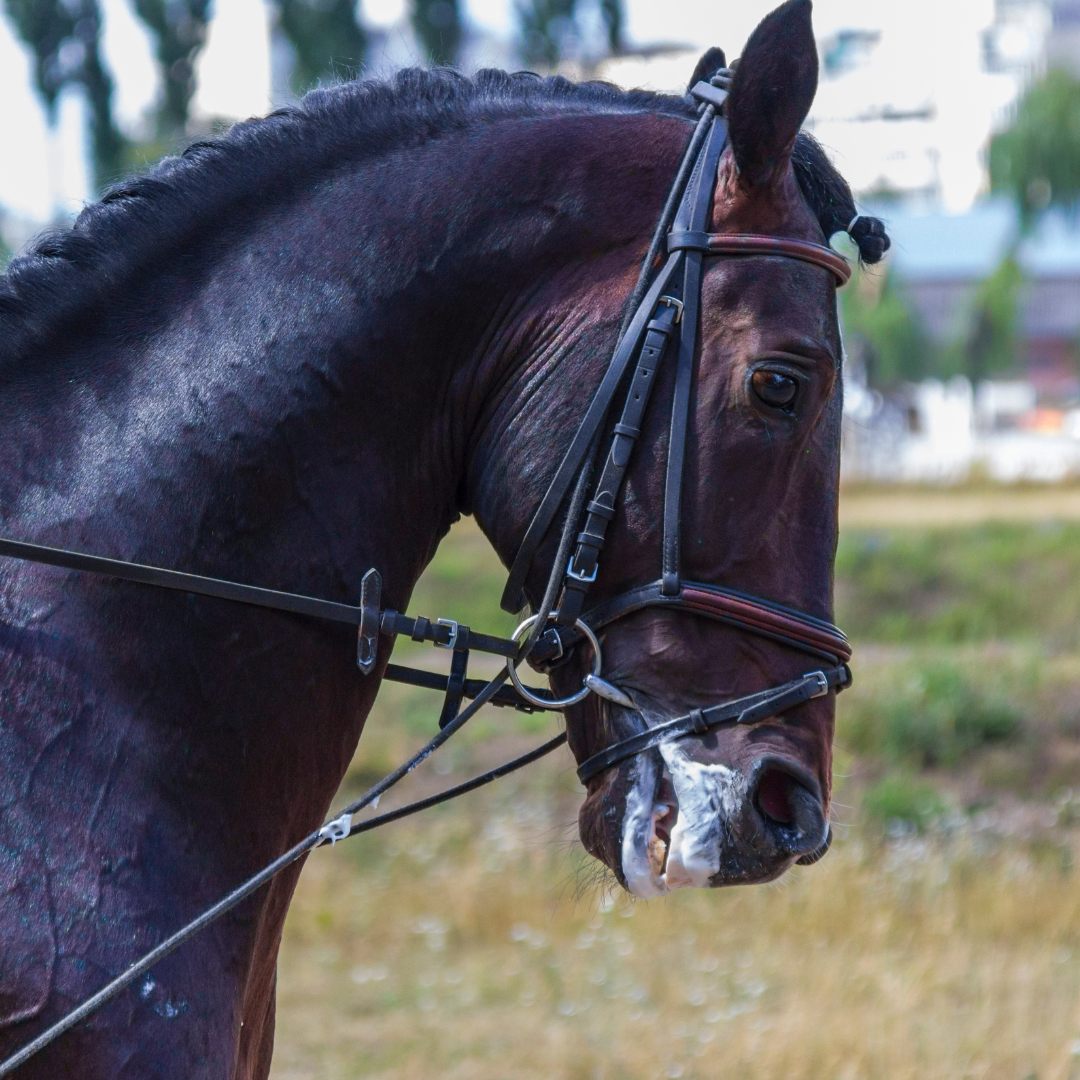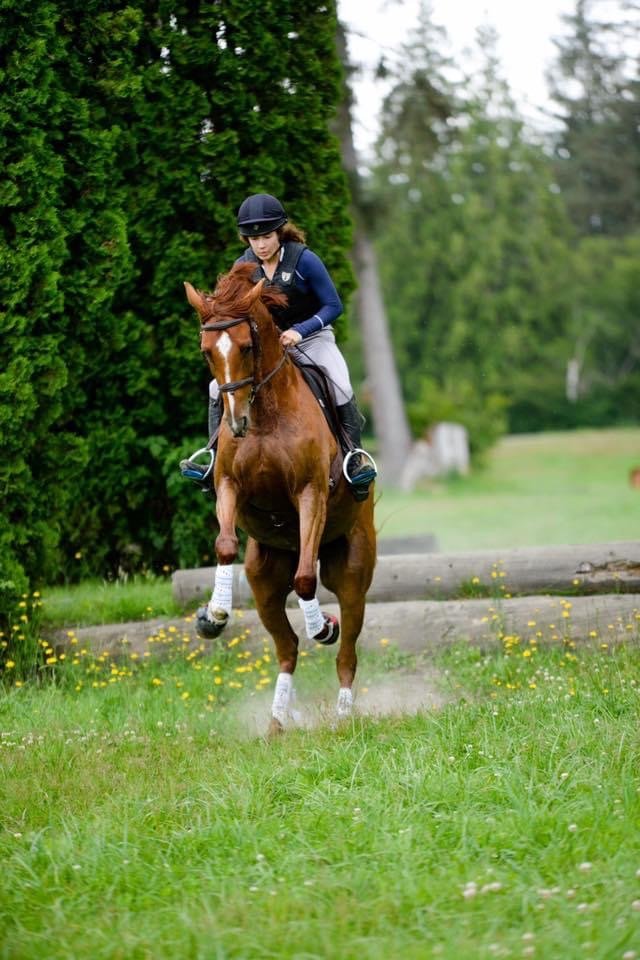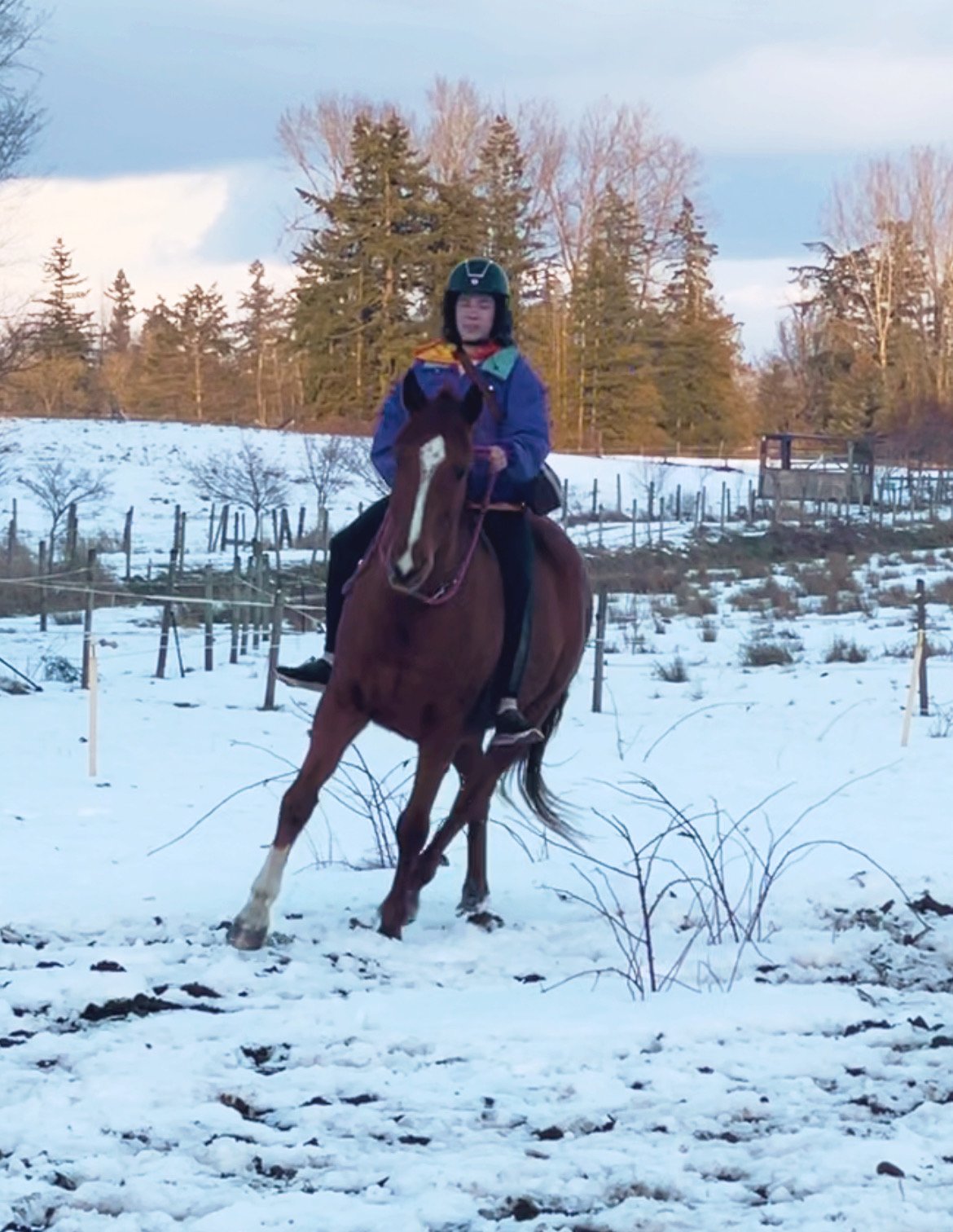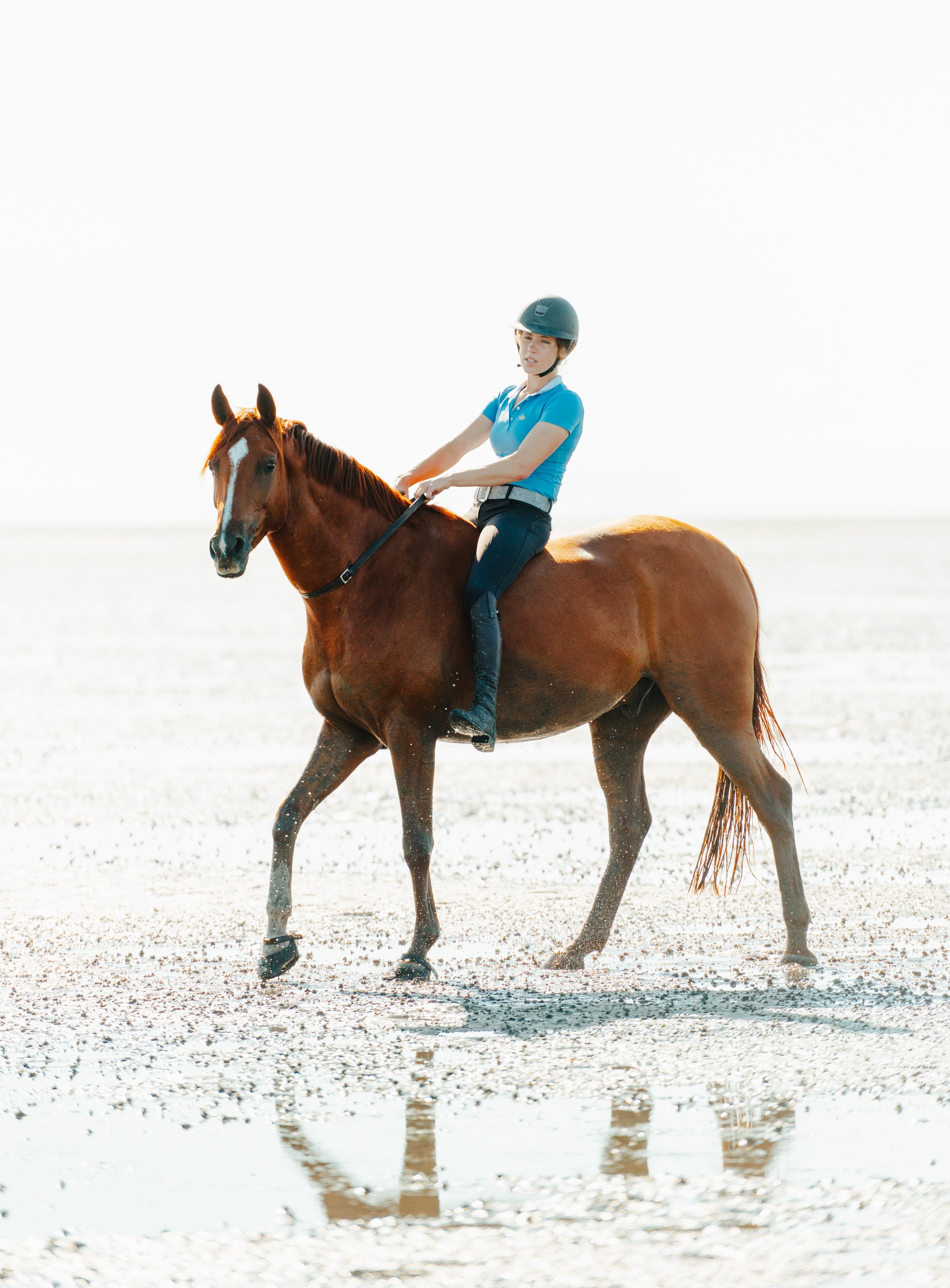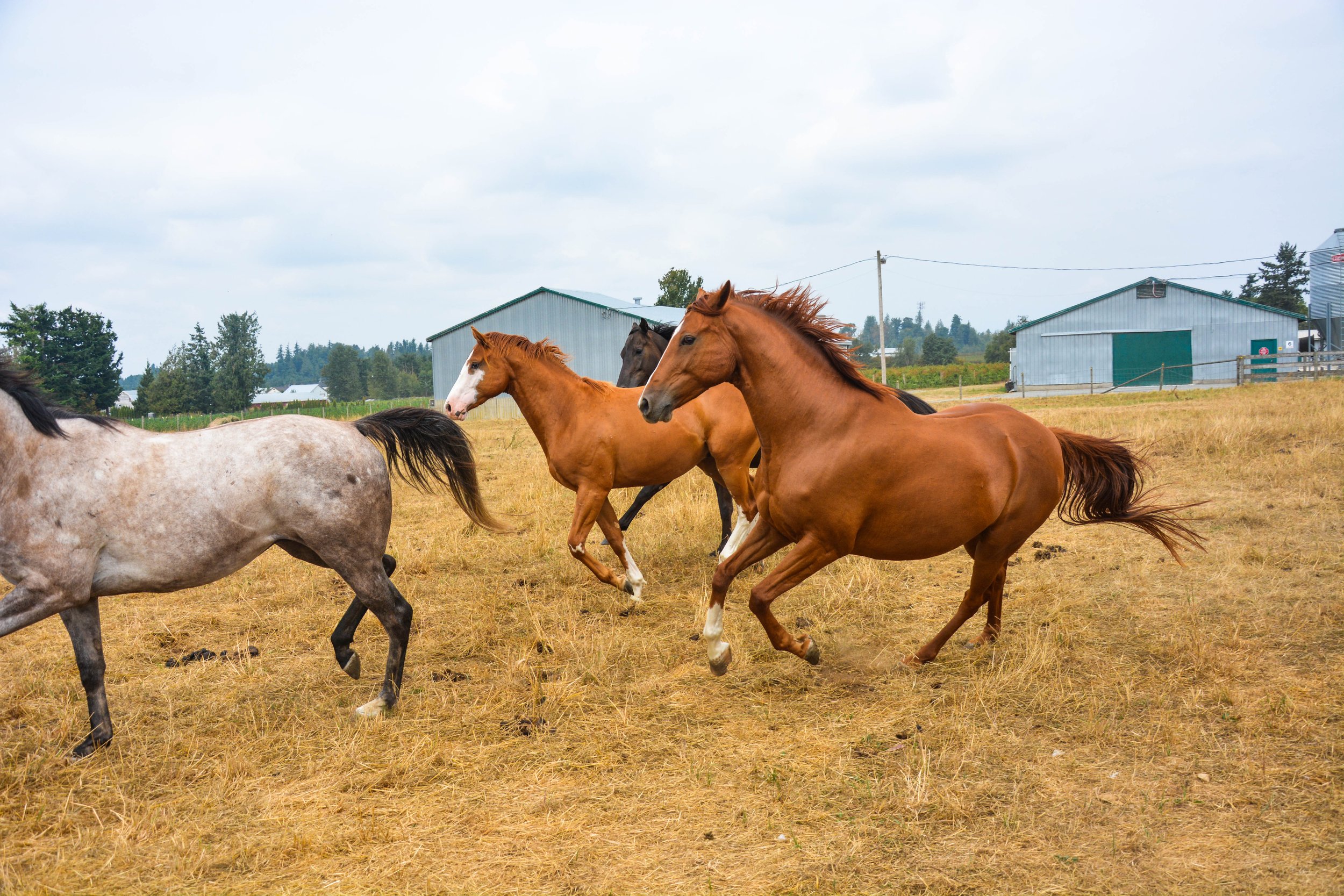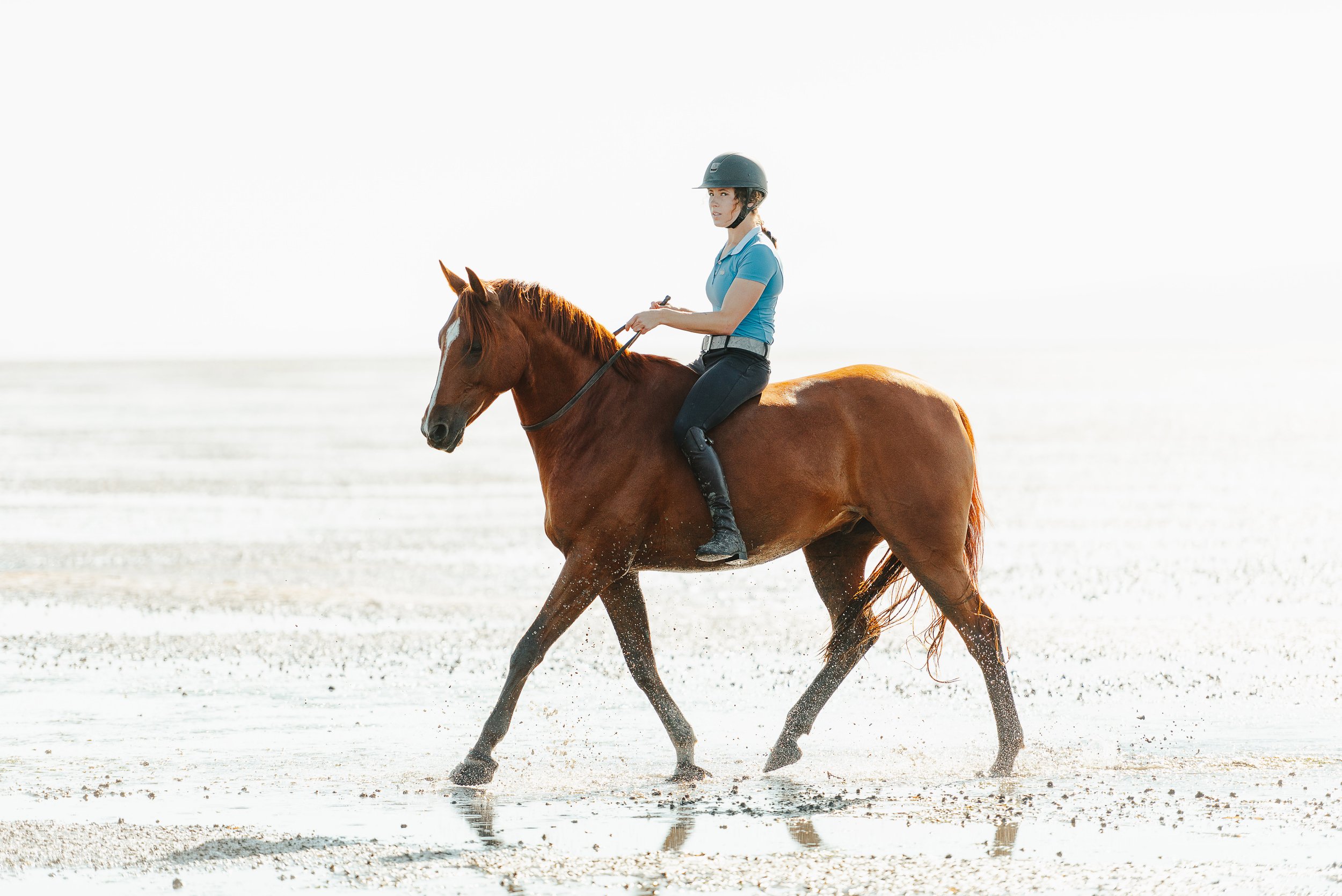Let’s talk about the elephant in the room in the horse industry: equine welfare and modernizing practices as we learn about the detriments of many normalized care and training practices.
Most, if not all, horse people are in the industry for the love of horses, even the ones who end up accidentally causing harm. The problem is, most of us struggle to find teachers and role models who teach us science based principles, emphasize reading equine behaviour correctly and model good management practices.
Because of this, we have crowds of well intentioned equestrians simply following what their idols, trainers and role models have told them to do, even to the detriment of their horses’ welfare, all while being blissfully unaware that there’s even a problem.
I know this because I was one of these people. Growing up, I had the whole stall and small individual paddock lifestyle normalized to me. Horses would go out for a few hours a day into paddocks slightly larger than their stalls and then would be back in the stalls for the majority of the day. There was a high instance of stress behaviours aka “stall vices” but I was taught that weaving was just the horses “playing” or dancing and that cribbing was just a quirk, rather than the indicators of high stress and poor management conditions that they were.
Being around chronically stressed horses made it difficult, if not impossible, to tell a stressed horse from a relaxed one. Unless the horse was completely over threshold and obviously reacting to stress, I would miss the signs because I had never been taught to recognize them. Even in instances where horses were being explosive, I would often view it as excitement, them “being bad” or them trying to push me around. I did this because this is what I was taught to do.
For years, I watched my trainers, barn friends and everyone around us at shows and other facilities engage in nearly identical practices. I watched horses go into the show ring with bloody spur patches. I watched my instructor knee horses in the belly if they bloated while being girthed. I watched her tie my horse’s head to his girth while he wore a kimberwicke bit at a show, to “teach him not to be heavy”. She left him like that for almost an hour, until his muscles were convulsing from over use.
I distinctly remember being uncomfortable but as a nine year old child, I assumed that I was the one in the wrong for feeling that way. My trainer was all knowing, the epitome of horse knowledge to me at the time.
I was taught to seesaw my horse’s face when he was “bad” aka always spooking and bolting due to lack of time outside. I was taught to kick hard or spank with a whip when he didn’t want to go forward because he was “testing me”. I was taught to punish first and ask questions later.
I learned that good horse management required a stall. Horses needed stalls, they loved their stalls. It was like their “little safe space” I was told. Even as they existed in 10x10 boxes with boarded up walls, nothing to do the majority of the time due to set hay feedings that they would consume quickly, leaving them standing around with empty stomaches for hours.
I was taught that group turnout was too dangerous and that it wasn’t necessary. For years of the beginning of my riding career, the idea of horses needing socialization never even crossed my mind. And so, I deprived my horse of the very things he needed most for years, all while having no idea I was doing it.
As a result, my horse was chronically spooky and had a bolting problem. It made me frustrated with him and more likely to engage in the punishments I was taught and consistently reinforced for when I did them.
When I did eventually move my horse to a farm with better management, where he lived out in a herd on 20 acres, his bolting problem immediately disappeared. Suddenly, he wasn’t spooky. This was eye opening to me and was the beginning of major changes in my horse handling as I knew it.
Many of the horse people who are now training the younger generations grew up learning during times where we did not have the internet access we do today. We didn’t have groups of horse people who were easy to connect with. We didn’t have the same number of informative, easy to find and read websites on horse care and management. We largely relied on word of mouth, what we saw and what our role models taught us.
And when everyone around you upholds the same, or similar enough, horsemanship, it creates an echo chamber of false information that you learn to never question because “everyone does it”. If you ever do question it, you’re quickly dismissed, sometimes even made fun of by your trainer. You’re told you’ll create a monster if you “let your horse get away with things” aka stop constantly punishing them for behaviours that never actually go away anyways because the underlying cause is never addressed.
The problem is that this type of training and handling is so normalized that you can see it anywhere. Go spend a day at any show and you’re guaranteed to see some unfair training practices. Be it a trainer laying into a horse with a whip in the warm up ring after a refusal, someone whacking their horse repeatedly with the end of a lead rope as the horse tries to run away, lunging horses for hours into fatigue, bloody mouths and spur marks, hyper flexion…. You’ll likely see something along those lines.
And if you don’t? Maybe you got lucky or maybe you’ve been taught to tune out a lot of these welfare issues we are now much more aware of thanks to the number of studies and scholarly articles now publicly available on horses.
You’d be hard pressed to go to any show and not find a horse who is exhibiting clear signs of stress or has a pain face.
I’ll take it a step further: you’d be hard pressed to go to any barn that has horses stalled for the majority of their day and not see stress behaviours or at least stressed faces and miserable shutdown horses.
Noticing the difference between the demeanour of my own horse and horses at my old show barns vs the ones at a place that did 24/7 group turnout was a huge culture shock. It was the most obvious and blatant way I could have been shown the importance of group turnout, there was no coming back from it, it was such a remarkable and clear difference.
And it allowed me to enjoy my horse more, it benefitted me directly, even without factoring in his welfare. I say this because so many horse people don’t want to change. They think that science based practices will lame their horse or make their behaviour worse despite the lack of evidence depicting that and in fact, more evidence depicting those concerns in relation to traditional practices.
If we didn’t have so many people upholding improper care and training practices, it could not be as pervasive. People actively engage in these practices and there’s people who watch it happy and say nothing, taking on the “not my horse, not my problem” Mindset despite the fact that welfare issues should be all of our problems.
People get reactionary and try to silence, personally attack and blame people for sharing information they feel targeted by. The number of times I’ve been personally attacked by strangers after sharing scholarly info on how many risks excessive stalling has, I can’t even count. They attack me, not the information. Not the equine scientists testing the info.
They want the info to not be shared. They don’t want to see it, because they feel triggered by it. This has resulted in horse people labelling the sharing of information as bullying, if the information targets biases they’ve yet to let go. It’s allowed horse people to carry the belief that science is optional, that they could have some miracle horse that this extensively researched information does not apply to.
It’s allowed for horse people to feel so entitled to their dissonance and their comfort that they view it as acceptable to try to intimidate people who advocate for change into their silence. They’ll insult your training ability: “if you believe insert science based practice here then you’ve clearly never handled a difficult horse” or “you’ve never trained a horse if you think that!”
Personal attacks on experience level are super common, even in instances where you’re sharing information you played no role in researching. The lengths people will go to to uphold this cognitive dissonance and refuse to consider new practice is troubling.
Most people who slam modernized practices like R+ and group living management practice haven’t even tried it, or haven’t given it a real proper try, before deciding it doesn’t work. Despite the overwhelming evidence proving it absolutely does.
The idea of causing their horse harm and/or having to change the way they do things is so aversive to them that they’d rather risk continuing to harm their horse than questioning practices that have been normalized by other people who share the same biases or were fed the same misinformation.
The horse world needs to change. Horses are depicted in so many abusive and cruel situations online with absolutely no shame. The amount of physical punishment used and justified for horses far exceeds that for other animals. People will even proudly gloat about how much they beat up their horses, garnering tens of thousands of likes and a lot of support.
This reflects poorly on all of us. It is going to be the undoing of the industry. The apathy, or worse, pride towards harshness to hoses is going to ruin us. To any normal person, it looks disgusting. It looks like we don’t love our horses and that they’re merely tools or vehicles for our personal pleasure.
To other horse people who’ve been there, we may understand the level of indoctrination leading to people being that way but no one else will see it that way and regardless, it’s the individual person’s responsibility to continue to learn and better their horsemanship, even if you had bad role models. It is your job to be open to reading credible information even if it conflicts with everything you’ve been taught.
Otherwise, the truth is that you don’t want to learn. That you don’t want the truth. That you’d rather engage in what is easiest for you over what is most fair to the horse and what is true info. And frankly, those of us who have decided to learn and reform our practice are too tired to coddle you.
I’m not going to lie to people anymore and say that the delusions they hold from misinformation are as justified as extensively researched and tested practices for horse training and management. If they want to hold onto untruths, no one owes it to them to hold their hand.
We need to adapt with the times. There are many normalized practices horse people have engaged in for decades that we are now well aware of being mentally or physically detrimental, or both. There is a way to make this world safer and more enjoyable for both horse and human.
The amount of stress behaviours that would cease to exist if we started to do an industry wide reform is something I think about a lot. The number of riders who would enjoy their horses more, with less frustration, if they addressed the actual causes of unwanted behaviour rather than just working to suppress the behaviour…
The problem is many horse people create a self fulfilling prophecy of unwanted behaviours because how they manage and care for the horse creates conflict behaviours that then inconvenience or endanger the rider and need immediate fixing that generally requires more suppression. They use the horse’s bad behaviour as a reason for needing harsher practices to not let the horse “get away with things” and assume softening practices could never work.
Starting to train and manage horses in a way that addresses WHY behaviours are existing rather than just focusing on making said behaviours cease to exist is how we better the horse world.
We love horses, right? So, why are we so set on upholding training and care practices that suppress their personalities, completely halt their side of communication and make it all about ourselves, stress them out, make them more prone to a number of physical issues as well as mental AND make them more dangerous to us?
Humans and horses can both win if we work on reforming the horse industry to consider horses as much as we work to consider human goals and desires. It simply isn’t happening currently and that’s a sad reality.
So, next time you see a post with information that triggers you or a post calling out industry wide issues, instead of commenting to plead your case of why you’re not like that / why it doesn’t apply to you or how “not all horse people are like that” consider this: Enough are and if you don’t feel the post applies to you, it shouldn’t be triggering. So, if you find yourself being upset any time you hear posts calling for better horse welfare, maybe it’s time to sit and think on why these posts trigger you.
For me, it was because they did apply to me and I wasn’t ready to realize where I was going wrong in my horsemanship, so I would deflect, deflect, deflect.
We cannot silence the discussion of better welfare if we want to improve industry standards. We need better education of horse people, better welfare standards in all barns and higher standards at all competitions. We can do better by our horses, we have extensive information showing us exactly where to start making changes.
Its time for horse people to put their egos and their personal comfort aside and let the horses have a turn having their comfort, wants and needs considered to the degree we have historically considered ourselves, the humans, first in the horse world.
Otherwise, we will be our own demise because those not brainwashed by horse industry-specific misinformation see our posts, now widely available to the public thanks to social media, and think we are all ignorant to welfare issues, think that we all find amusement in hitting our horses and guess what? They want to see our industry crumble because they fail to see the good in it.
They only see a huge number of people completely closed off to considering where they could do better and refusing to consider any rationale showing them why certain things are issues in the horse world.
We have to care enough to make these changes before it’s too late. If people won’t change until they have the threat of the industry losing its social license and going under held to them like a knife to the throat, our industry will collapse. If people only start caring about bettering and modernizing practices when they’re at the risk of losing everything, did they actually ever care at all or is it all related to damage control for their benefit?
It’s time to have more honest discussions about welfare and training practices in the horse world and how we can reduce the high instances of stress behaviours we see. We need to do it for the horses. They are voiceless and utterly reliant on us having the backbone to speak up, even when we so often are speaking to an echo chamber that does not value science.
We can make changes that directly benefit our horses and as a result, us. Happier horses will perform better, be safer to deal with and will enjoy being around humans much more. The proof is there
It’s time to seriously start talking about the desperate need for reform in the horse industry.
Are you ready for some self reflection and being open to information that may hurt to hear, if it will benefit your horse in a positive way?
Some scholarly resources discussing some of these common issues:
Study on high science based training limits stress and thereby injury to humans from horses
https://www.ncbi.nlm.nih.gov/pmc/articles/PMC4810043/
Study on tight nosebands and welfare deficits
https://www.ncbi.nlm.nih.gov/pmc/articles/PMC7552251/
Mouth pain in horses
https://www.ncbi.nlm.nih.gov/pmc/articles/PMC7222381/
Investigating equestrians perception of horse happiness (spoiler: they often perceive stress behaviours as signs of happiness)
https://pubmed.ncbi.nlm.nih.gov/34416986/
The importance of free choice access to forage for horse welfare
https://pubmed.ncbi.nlm.nih.gov/22444907/
Investigation on equestrian spur use
https://www.sciencedirect.com/science/article/abs/pii/S1558787819300784
Negative and positive reinforcement compared for rehabilitating horses
https://www.researchgate.net/publication/37147132_Negative_versus_positive_reinforcement_An_evaluation_of_training_strategies_for_rehabilitated_horses
Bit related lesions In event horses study
https://www.ncbi.nlm.nih.gov/pmc/articles/PMC8044447/
Turning horses out not only betters welfare but improves environmental health
https://www.mdpi.com/2071-1050/13/16/8991
Colic instance in horses
https://ker.com/equinews/colic-incidence-stalled-horses/
Comparing stalled vs pastured horses
https://www.ncbi.nlm.nih.gov/pmc/articles/PMC6466050/
Turnout time greatly reduces risk of soft tissue injury
https://thehorse.com/1101677/turnout-time-can-reduce-horses-risk-of-soft-tissue-injury/
Stereotypic behaviour in horses
http://www2.ca.uky.edu/agcomm/pubs/ASC/ASC212/ASC212.pdf
Horses stabled alone (stress study)
https://www.horsetalk.co.nz/2015/03/20/horses-stabled-alone-stress-study/
Study on management practices
https://www.sciencedirect.com/science/article/abs/pii/S0168159116301046
Consequences of stall confinement
https://thehorse.com/121297/consequences-of-stall-confinement/
Stress impacts learning study
https://journals.plos.org/plosone/article?id=10.1371%2Fjournal.pone.0170783
Learning theory and it’s application in horse training
https://oup2-idp.sams-sigma.com/authorize?auth_token=eyJhbGciOiJSU0EtT0FFUC0yNTYiLCJlbmMiOiJBMTI4R0NNIn0.H09FvJSWSVXFcY2MdHW-Cgm8Z87RKDHtuaURqvT9o_EgWLaZdENsvtwVVdKlHkC5k-73_rV3dt13cH7hqfkbIQH2ZBmJRw-Sy85PJAN4s3rbGqAuTtW9KW6SNCw0hYVB1z8LpHUFBoERHVRobaHjHx_2w3vCOQMqDuuVXcsBUZMGqYHTVWKkwmZfHctMTlhD_KhBA-3Q3rA-rzhkFMERuyuZJr5I-Zcgx0Tr-1xpnVub2Nn_V8xGdBVu5e1ReIVtg2pRFXHkPkYdyB6lkB5vv6U1cgbBUnyjYdbRsRDyA-bChqxDWnD529Mm0ki18BOH2zMDS1Hg0R_ap2mCFxfzmw.JZKtPSnI80hMOr17.Fk4NAzn-IL_I-LQIsFvgtMLTwxVyUmVT0YIfvLi-aKiaZmCzUaPrPeHq56MnEVP9FRKinCvV5RlakEy9QI5gJDGQBi5Hkfi0-1z1wiE1k7truZiFTiOiOyTF9WdXzU38EenZytK95656n-q48JKUDybonqxmo_ETvTqiu5BbHpicEjEgBD4_dFw8H4OUroayYMvQIJA2LqOq5syD1CW3BTT9Mkc.QxWeRlknDEk1Zbng2moLyw&ip_address=184.65.72.124&prompt=none&referrer_url=https://milestoneequestrian.ca/&response_type=code&scope=openid+profile+email+license_lite+profile_extended+offline_access&redirect_uri=https://academic.oup.com/HTTPHandlers/Sigma/LoginHandler.ashx&client_id=ACADEMIC&state=00796d3a-522e-4722-b22c-3b106434b8cbredirecturl=httpszazjzjacademiczwoupzwcomzjjaszjarticlezj68zj1zj75zj4703981
Assessment of stress in horses during competition
https://orbi.uliege.be/bitstream/2268/69893/1/MariePeeters_abstract%20JVB.pdf
